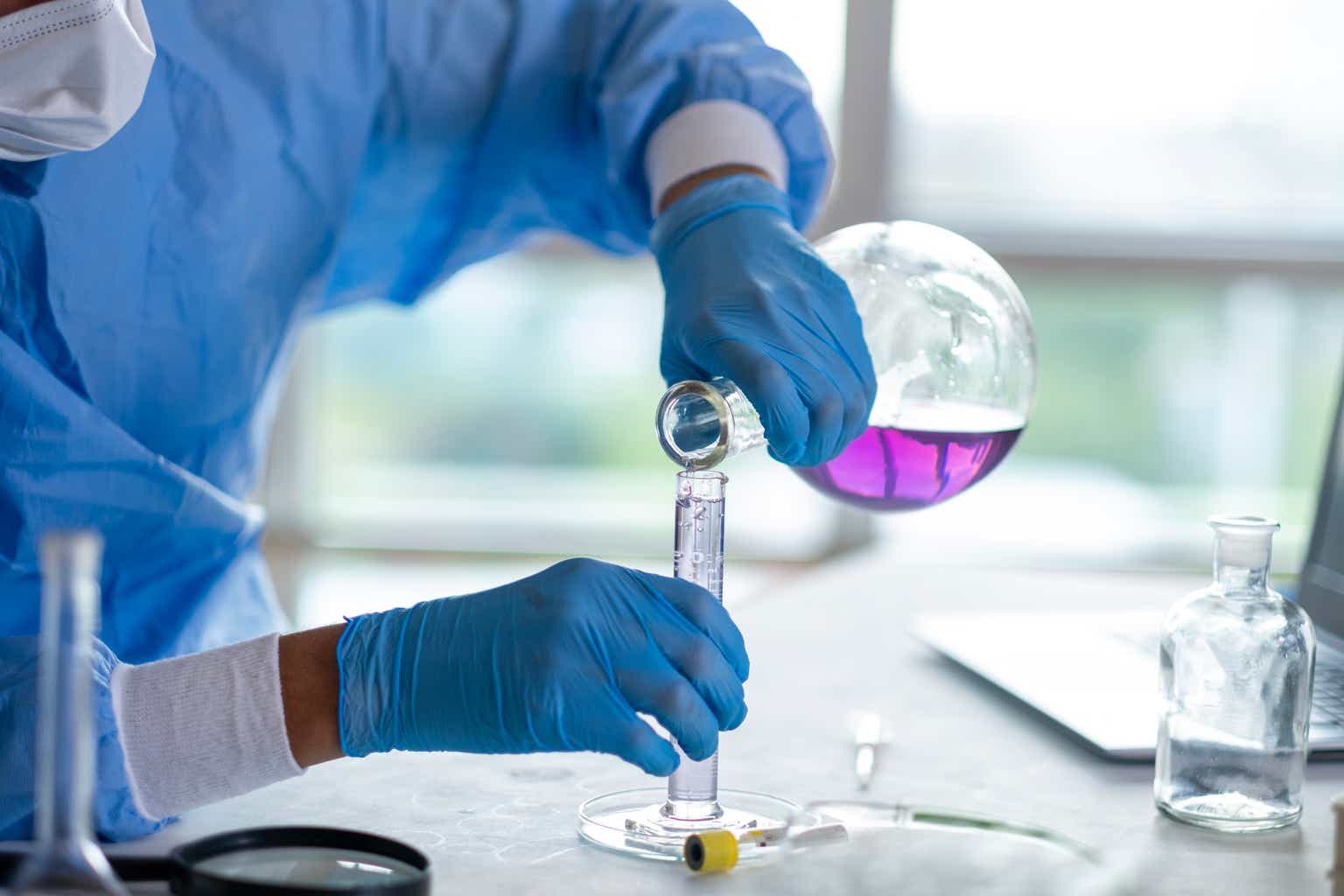uchar/iStock via Getty Images
Solid Biosciences (NASDAQ:SLDB) is hoping to advance a next-generation gene therapy for the treatment of patients with Duchenne Muscular Dystrophy [DMD]. This would be with a gene therapy candidate by the name of SGT-003, which is expected to be incorporated with the company’s proprietary AAV-SLB101 capsid. The key feature is that it offers a shortened form of the dystrophin protein [microdystrophin], with the advantage of offering increased transgene expression and durability of response over existing AAV9 gene therapies being used to treat these patients. I believe that it is a buy just based on the fact that it is advancing its very own unique SLB101 capsid for the treatment of patients with DMD. The reason why I bring this up is because this could possibly create a competitive advantage over another FDA-approved gene therapy for DMD. Thus, the ability to target microdystrophin to treat this patient population has already been established.
What Solid Biosciences is doing is taking this one step further by possibly enhancing upon the efficacy of such a gene therapy treatment. An IND was given clearance by the FDA so that a phase 1/2 study targeting pediatric DMD patients could begin. It remains to be seen if efficacy can be improved upon, but there are two catalysts that investors can look forward to this year, which might be able to boost the stock price. The first catalyst would be the dosing of the first patient in this phase 1/2 study expected in late Q1 of 2024. From there, it is expected that early biomarker data is going to be released from this early-stage study in Q3 of 2024.
In addition, the goal is to take this program globally, which means that there will be additional Clinical Trial Authorizations [CTAs] filed in the 1st half of 2024 so that it could begin global testing of this gene therapy for the treatment of patients with DMD. The thing about this biotech is that it is not pinning all its hopes on this DMD program, but it also expects to file an IND to the FDA for another gene therapy candidate by the name of SGT-501, which is going to be developed for the treatment of patients with catecholaminergic polymorphic ventricular tachycardia [CPVT]. However, the main goal is to target RyR2, which is responsible for causing disease. An IND filing to begin a phase 1 testing is not expected to be filed until Q1 of 2025, but at least this is another shot on goal with respect to a gene therapy in the pipeline.
SGT-003 For The Treatment Of Patients With Duchenne Muscular Dystrophy
The use of SGT-003 is being developed as a gene therapy to treat patients with Duchenne Muscular Dystrophy. As I stated above, Solid Biosciences just received IND clearance from the FDA to begin a phase 1/2 study using this specific gene therapy for the treatment of these patients. Duchenne Muscular Dystrophy [DMD] is characterized as a genetic disorder with progressive muscle loss. The reason why this occurs is because of the loss of dystrophin, which is a very important protein that keeps the muscles intact. Without it, these DMD patients experience muscle problems over time. It usually starts to develop in early childhood, which would be between the ages of 2 to 3. It primarily develops in boys, but in rare instances can also occur in girls as well. With the lack of dystrophin, these patients have trouble with muscle movement such as walking or running. However, later on, this rare genetic disorder can also affect the heart muscle and respiratory system functions as well. The FDA has already granted Fast Track Designation of SGT-003 for the treatment of patients with DMD, however, there was another recent positive development with respect to this program. That is, the agency also gave this gene therapy Orphan Drug Designation [ODD] as well. The significance of this is that Solid Biosciences is capable of obtaining a multitude of benefits because of such a designation. For instance, Solid Biosciences would be entitled to tax credits for clinical trials that qualify, along with an exemption from user fees. In addition, there is the possibility that it could end up having 7 years of market exclusivity as well.
The global Duchenne Muscular Dystrophy drugs market is expected to reach $27.4 billion by 2030. This is a very large market opportunity for sure, but it won’t be easy given that there is a competitor in place. That is, the FDA has already granted Accelerated Approval of Elevidys for ambulatory DMD patients ages 4 to 5. The term “ambulatory’ means such patients who can still walk. This gene therapy was developed by Sarepta Therapeutics (SRPT) and might end up being a competitor that Solid Biosciences may have to go up against. The thing is that there are two possible scenarios whereby Solid Biosciences might be able to overcome such a competing gene therapy. The first would be with respect to Sarepta’s own advancement, which is that it has suffered a major setback. When it reported results from its phase 3 confirmatory EMBARK study, it noted that Elevidys failed to meet the primary endpoint of North Star Ambulatory Assessment [NSAA] at 52 weeks. That is, the gene therapy failed to separate from placebo with respect to this functional improvement endpoint. Patients given Elevidys saw a 2.6-point improvement, compared to patients on placebo who only established a 1.9-point improvement. Thus, the trial was not statistically significant with a p-value of p=0.24. The problem here is that despite the missing of this primary endpoint, Sarepta is still seeking to expand FDA approval of Elevidys to all DMD patients who can walk, not just those only 4 to 5 years of age. There is no guarantee that the agency will move to approve this label expansion, thus this is one way Solid Biosciences can avoid this type of gene therapy as competition. Not only that, but the failure of the confirmatory trial might also mean that the FDA holds the power to remove the original regulatory approval of ambulatory DMD patients off of the market. However, this is something that is ultimately up to the FDA and may not happen. With the phase 3 EMBARK trial setback with Elevidys, plus the fact that the gene therapy could be pulled off the market, this puts Solid Biosciences at the forefront.
Another possible competitor in the gene therapy space might end up being Pfizer (PFE) with its treatment known as PF-06939926 or fordadistrogene movaparvovec, which is being explored in a phase 3 study for the treatment of DMD patients. This trial is going to target such patients who are between ages of 4 to 7 years of age. It is expected that a total of 99 patients are going to be enrolled in this study, whereby patients are going to be randomized to one of two treatment arms as follows:
- Cohort 1 – Receive gene therapy fordadistrogene movaparvovec: Two-thirds of patients randomized to this cohort
- Cohort 2 – Receive placebo treatment: One-third of patients to be randomized into this cohort year 1, with potential to move to treatment with gene therapy after year 1 barring it is safe to do so
These patients are going to be evaluated based on the primary endpoint of this late-stage study, which is going to be North Star Ambulatory Assessment [NSAA] over a 52-week period of gene therapy compared to placebo from baseline. There are two possible scenarios here whereby Solid Biosciences could benefit in terms of overcoming competition from Pfizer’s gene therapy. The first is that final data analysis from this phase 3 study of fordadistrogene movaparvovec for the treatment of children ages 4 to 7 years of age with DMD, is not expected until the 2nd half of 2024. Should this trial also fail to meet the primary endpoint of NSAA at 52 weeks, then this would be a major setback for Pfizer’s program. A second setback was that such a gene therapy had safety issues. First, in August of 2021, the study was paused following three adverse events that had occurred during testing, with two of the AEs dealing with myocarditis. The trial had then resumed in November of 2021, before having another hold placed following a patient death. With an amended protocol put in place, the FDA hold was lifted and the study was able to continue. There have been no other issues since then, but should another problem arise before or upon the release of final results, then this would be a major issue going forward for the pharma. Ultimately, Solid Biosciences is going to have to achieve similar or superior safety/efficacy if it hopes to fend off its gene therapy competitors.
One way it might ultimately do so would be with respect to differentiation. How so? Well, that’s because SGT-003 is being developed with Solid Biosciences’ proprietary capsid known as AAV-SLB101. This is a very important distinction because this capsid is expected to allow this gene therapy to become a next-generation gene therapy for the treatment of patients with DMD. It is designed to deliver a shortened form of microdystrophin, with R16 and R17 nNOs binding protein domains. The essence of this is that greater transgene expression of microdystrophin can be achieved for the patient. In essence, such a capsid could overcome the other gene therapies that only use either an AAV9 or rAAVrh74 vector. The rAAVrh74 capsid from Sarepta’s Elevidys is less immunogenic than its AAV9, AAV2, and AAV5 counterparts, but is still able to transduce gene expression of microdystrophin. The hope is that the newly developed capsid from Solid Biosciences can improve the science of using gene therapies to restore microdystrophin in DMD patients. In preclinical testing, AAV-SLB101 as a proprietary capsid was able to induce far greater skeletal muscle tropism over its AAV9 counterpart. Such tissue tropism means that the pathogen is able to infect a far greater range of target cells and tissues. Thus, it is the expectation that SGT-003 could end up achieving superior efficacy over Sarepta’s Elevidys or Pfizer’s fordadistrogene movaparvovec.
Financials
According to the 10-Q SEC Filling, Solid Biosciences had cash, cash equivalents, and available for sale securities of $142.9 million as of September 30th, 2023. It believed that it would have enough cash on hand to fund its trial and pipeline into 2025. However, barring that it only had roughly a little bit over 1 year’s worth of cash, it chose to enact a private offering. Such a private offering included the selling of 16,973,103 shares of common stock at a price of $5.53 per share and, in lieu of common stock, pre-funded warrants to purchase up to 2,712,478 shares of common stock at a price of $5.529 per pre-funded warrant.
This agreement was done by including both new and existing institutional investors and helped to raise approximately $108.9 million. It is now going to have an extended cash runway to fund its pipeline and its operations. Why is that? As I stated directly above, it believed that its cash on hand would be enough to carry it into 2025. Well, the newly added funds of $108.9 million into the mix should be enough to carry it forward for three quarters. The reason why I say that is because the quarterly cash burn rate per quarter is $28 million in expenses. Thus, I believe this newly added cash will help it to advance for several quarters on top of its original projection of cash only being enough into 2025.
Risks To Business
There are several risks that investors should be aware of before investing in Solid Biosciences. The first risk to consider would be with respect to the recent IND clearance of SGT-003 as a gene therapy for the treatment of patients with Duchenne Muscular Dystrophy [DMD]. That’s because initial biomarker results from this phase 1/2 study are expected to be released in Q3 of 2024. There is no assurance that this gene therapy will be able to restore the necessary microdystrophin to allow for greater muscle movement. A second risk to consider would be with respect to potential competition. That’s because it is going to have to prove that SGT-003 can provide better transgene tissue expression over Elevidys and fordadistrogene movaparvovec.
I noted above that it might be able to differentiate itself away from these other gene therapies in that it is using a different capsid. That is, it is believed its AAV-SLB101 capsid can provide for improved tissue distribution and ultimately efficacy. A third risk to then consider would be in terms of safety, which is another possible issue that might arise. How so? Well, the use of the newly proprietary AAV-SLB101 capsid has not yet been tested in humans. Despite showing improved skeletal muscle tropism in preclinical testing, there is no guarantee that it will be safe, nor that there won’t be any major side effects. Not only that but what is typically observed in preclinical testing doesn’t always translate into human testing, thus another major risk factor.
Conclusion
Solid Biosciences has a few catalysts for investors to look forward to this year. The first of which, being a small one, would be the initiation of the phase 1/2 study using SGT-003 for the treatment of patients with Duchenne Muscular Dystrophy [DMD]. One thing to note is that this company will have to start off with a set group of children to treat. That is, it is going to only recruit children between the ages of 4 to 6 years of age for this trial. I believe that investors can greatly benefit off of the fact that it is not intending to develop SGT-003 as a “me too” type of AAV9 gene therapy. Instead, it is attempting to advance its own AAV-SLB101 capsid instead. Whether or not such a move ultimately means the ability to get through all clinical trial testing, plus regulatory approval, remains to be seen. Still, there is the potential to improve upon that has already been achieved with the delivery of microdystrophin through the use of a new capsid.
The initial biomarker/functional data to be released from this phase 1/2 study is going to shed more light on whether or not this approach can ultimately be successful. The last thing to note about this biotech is what I noted above, in that it is not pinning all its hopes on only advancing SGT-003 for the treatment of patients with DMD. It is also in the process of developing a gene therapy known as SGT-501, which is being advanced for the treatment of patients with catecholaminergic polymorphic ventricular tachycardia [CPVT]. This is a terrible disease because it is not adequately addressed. It is said that there is a mortality rate of 40% over a 10-year period. An opportunity here for Solid Biosciences with SGT-501 is that there are no approved therapies for these CPVT patients. Thus, if it is able to successfully navigate this gene therapy in human testing, then it could possibly eventually become the first treatment option for this patient population. As I explained above, I believe it is a buy because of its differentiation factor. That is, it is developing its very own unique SLB-101 capsid, which may generate potential competitive advantages over other gene therapies being developed to treat patients with DMD.
Credit: Source link







































